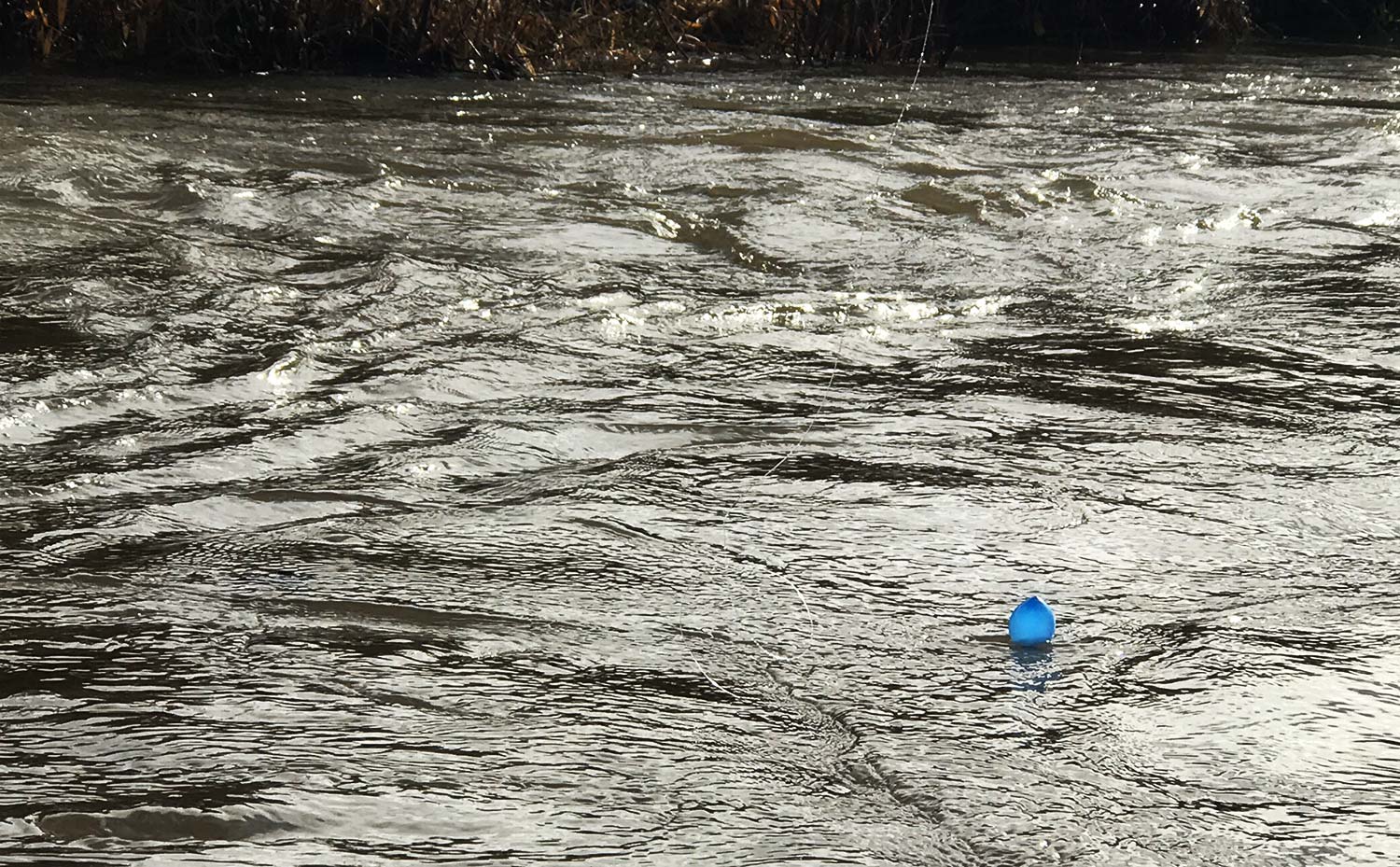By Justin Pickett
“What the heck kind of indicator is that?”… “it’s a balloon.”
Not too long ago I received a phone call from a good friend of mine asking if I could help with a guide trip for a handful of folks who were on the books. It was a group of five anglers, and the second guide that he had booked fell ill and had to back out. I didn’t have anything on my plate the next day so I gladly agreed to pick up another day on the water.
It had rained overnight, which in my eyes is a good thing so long as it isn’t one of those earth-carving downpours that blows rivers out to the point “ain’t no way in hell I’m going near that water.” The right amount of rain will stain the water and raise the flows just enough to get trout feeling frisky, causing them to lose their inhibitions and feed with abandon. For me, the conditions I just described make my stripping hand itch. I reach for the heftier sticks, sinking lines, beefy tippet, and beefier flies. Sex Dungeons and Boogie Men come to mind when I think of days like these. However, when you find yourself on the water with a client, things have to change. You have to play to their strengths, and, on this day, the best plan was to nymph. With the day’s conditions, we would be afforded the ability to have our clients throw larger indicators that would float big, gaudy flies without spooking an entire run.
Prepared for a successful day, my fellow guide, Noland, and I discussed the plans for the day and basically split the water in half so we didn’t beat all of the water to death. Fishing was good and soon came lunch. On our way back to the trucks we encountered Noland with his group of anglers and stopped to take a gander and engage in some small talk. As I’m talking with Noland, I noticed something funky about his client’s rig. Something just seemed off about it as he picked it up off the water and began his next cast. As this gentleman’s flies and indicator hit the water it became a little more obvious as to why I had this impression.
“What the heck kind of indicator is that?” I asked as I turned back towards Noland.
With a smirk on his face, Noland replied with, “it’s a balloon.”
Well I’ll just be damned if it wasn’t a balloon! I royal blue balloon. I couldn’t help but chuckle at the idea that he would use a balloon as an indicator. Sure, there are offshore anglers using balloons to position their bait when fishing for a multitude of species, but as an indicator on a fly rig? No way! Obviously, I had to ask….Why? And the answer was simple. They’re cheap and they work.
 As a guide, you constantly have to replace things. Clients will break off flies and indicators. Leaders get trashed. Split shot gets slung off into oblivion. I’ll salvage a leader as many times as I can, but you can’t salvage something you don’t have. So to combat the cost of having to replace lost indicators, Noland has turned to small party balloons. First off, they’re cheap. A couple bucks will get you one hundred of these little rubber blimps. Second, they actually work really well. You simply tie them on the leader with a quick overhand knot, just as you would tie off any balloon. You can add as much air as you need to float your flies so you don’t need to carry multiple sizes. Adjusting depth is a breeze and doesn’t kink your leader. A little water or saliva along the leader and balloon knot is all you need to slide the balloon into the desired position. The water/saliva is a must. If you don’t lubricate before trying to slide the balloon, then the rubber will grip the leader and cause you some fits. And (one of the coolest things I noticed about using balloons) they don’t make a ton of racket or cause a big disturbance when they hit the water. These balloons are very light and land softly, and because they are so light they are easy for clients to cast. So now the only thing left to talk about is a balloon’s ability to actually detect a strike. Well, they do the exact same job as a thingamabobber would, and I think that the balloon of a similar size will do a better job simply because they are so much lighter than the actual indicator while maintaining seemingly equal buoyancy. An indicator that weighs less takes less energy to move and/or sink, thus making it more sensitive to strikes. It’s the same reason why I have been such a fan of the New Zealand indicator system. It is super light, yet has the ability to float multiple flies. The one thing I wonder (that I have not experienced) is the incidence of stray hook points and other pointy objects ruining your drift, though I would venture to guess that would certainly not be the norm.
As a guide, you constantly have to replace things. Clients will break off flies and indicators. Leaders get trashed. Split shot gets slung off into oblivion. I’ll salvage a leader as many times as I can, but you can’t salvage something you don’t have. So to combat the cost of having to replace lost indicators, Noland has turned to small party balloons. First off, they’re cheap. A couple bucks will get you one hundred of these little rubber blimps. Second, they actually work really well. You simply tie them on the leader with a quick overhand knot, just as you would tie off any balloon. You can add as much air as you need to float your flies so you don’t need to carry multiple sizes. Adjusting depth is a breeze and doesn’t kink your leader. A little water or saliva along the leader and balloon knot is all you need to slide the balloon into the desired position. The water/saliva is a must. If you don’t lubricate before trying to slide the balloon, then the rubber will grip the leader and cause you some fits. And (one of the coolest things I noticed about using balloons) they don’t make a ton of racket or cause a big disturbance when they hit the water. These balloons are very light and land softly, and because they are so light they are easy for clients to cast. So now the only thing left to talk about is a balloon’s ability to actually detect a strike. Well, they do the exact same job as a thingamabobber would, and I think that the balloon of a similar size will do a better job simply because they are so much lighter than the actual indicator while maintaining seemingly equal buoyancy. An indicator that weighs less takes less energy to move and/or sink, thus making it more sensitive to strikes. It’s the same reason why I have been such a fan of the New Zealand indicator system. It is super light, yet has the ability to float multiple flies. The one thing I wonder (that I have not experienced) is the incidence of stray hook points and other pointy objects ruining your drift, though I would venture to guess that would certainly not be the norm.
Now, I’m not saying that I have completely ditched indicators for balloons. And I’m certainly not running off the water to the closest Party City when I’m low on supplies, but I will say that these little balloons are one inventive way to solve a problem while also being very cost effective. Your traditional bobber-style indicators aren’t cheap, and if you are someone that loses indicators often and you are trying to save some coin, then this might be something to look in to. Heck, they might even be good to just keep in the gear bag as a backup!
Justin Pickett Gink & Gasoline www.ginkandgasoline.com hookups@ginkandgasoline.com Sign Up For Our Weekly Newsletter!
Sign Up For Our Weekly Newsletter!


I started using balloons as strike indicators in the 80’s while guiding the Henry’s Fork and Madison Rivers. Back then the only indicators available commercially were borrowed from other genres such as Lil Corkys from the steelhead/salmon gear guys and the pinch-on foam ones from the crappie angling world. Most fly guys before then, if they used indicators at all, used short sections of orange fly line threaded onto the leader or just colored butt section (called “sighters” now). That was fine for slow water or high stick nymphing but didn’t work well with a long cast and heavily weighted stonefly nymphs in fast water such as Box Canyon. Small balloons and big Corkys did the trick. I use Thingamabobbers more now because they are easy to get, very buoyant, durable, come in a variety of sizes/colors/translucencys and easy to attach/remove. I know many nymphers that still use balloons, as do I, when a really big float is wanted. Hard to beat for buoyancy and light weight.
The Far Side…classic
How big do I inflate the balloon to, for, say, a medium fast run with rocks and lots of mixed currents, using a couple of bead head nymphs? I am intrigued with this, and am always looking for a new way to do things.
I use Water balloons called bunch of balloons. They have a small rubber band on each balloon. You take one of the rubber bands off of another balloon and place it on the tapered leader to make a loop and then blow up the water balloon inside that loop. When you tighten the tapered leader the extra rubber band slips over the end of the balloon and hold it in place
Pingback: Story: Blow Up Bobbers | MidCurrent
How often are you losing the balloon in the stream? Just thinking about the waste side of things, but if it’s a lost balloon or bobber maybe it doesn’t make much difference.
Pingback: Story: Blow Up Bobbers | MidCurrent - Fishing Fly Tackle